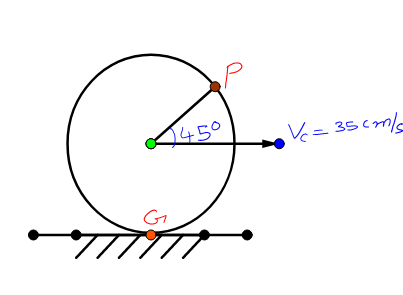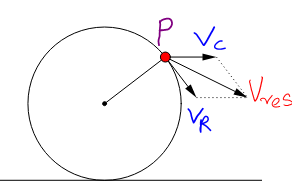Question
Question: In the figure shown, find the net velocity at point P? The diameter of the wheel is 35 cm and the ce...
In the figure shown, find the net velocity at point P? The diameter of the wheel is 35 cm and the center of mass velocity is 35 cm/s and the wheel is performing pure rolling.

50 cm/s
75 cm/s
65 cm/s
10 cm/s
Solution
- Hint: In this problem, it is given that the wheel is performing a pure rolling, which means that the resultant velocity at the contact point between the wheel and the surface is zero.
Complete step-by-step solution -

In the figure given above, we have denoted the different velocities at point ‘P’, they are Vc is the velocity of center of mass, VRis the rotational velocity, Vres is the resultant velocity at point ‘P’.
In the problem it is given that the wheel executes pure rolling, so the velocity at point ‘G’ is zero.
VG=0⇒ Vc−VR=0
∴VR=Vc
The angle between Vc and VR is . So we can calculate the resultant velocity using the formula,
Vres=Vc2+VR2+2VcVRcosθ
Substituting the values of Vc=VR and θ, we get
Vres=2Vc2(1+cos(45))
Vres=2×(35)2×cos(45)
∴ Vres=64.67≈65 cm/s
So the answer is option (b) 65 cm/s.
Additional Information: Rolling motion is the combination of pure translational motion pure rotational motion.
At the center of the wheel, only translational velocity will be present, rotational velocity will be zero.
Note: If the rotational velocity is equal to the translational velocity, the velocity at the top part of the wheel will be 2 times the translational or rotational velocity and at the point of contact with the ground the resultant velocity will be zero.
